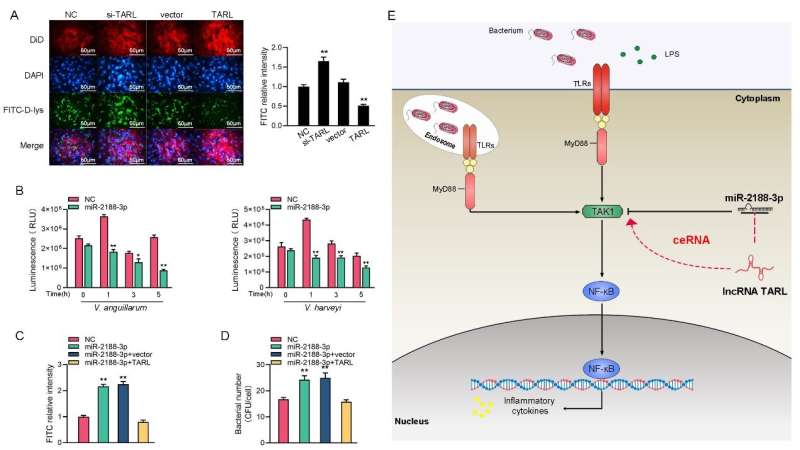This article has been reviewed according to Science X's editorial process and policies. Editors have highlighted the following attributes while ensuring the content's credibility:
fact-checked
peer-reviewed publication
trusted source
proofread
Long noncoding RNA TARL can help fish resist Vibrio infection by regulating the stability of TAK1

In a study published in the journal Science China Life Sciences, Miichthys miiuy in teleost was taken as the research object to explore whether lncRNA can play a regulatory role in the process of teleost resisting susceptible pathogenic Vibrio infection. And the researchers found that the expression of lncRNA TARL was up-regulated in the spleen tissue of M. miiuy stimulated by LPS.
Further analysis showed that lncRNA TARL can promote the expression of inflammatory cytokines, and can significantly promote the host to resist the invasion of Vibrio anguillarum, which indicates that lncRNA TARL can participate in the innate antibacterial immune response of M. miiuy, and can play a positive regulatory role. Nucleo cytoplasmic localization assay proved that lncRNA TARL is a cytoplasmic localization lncRNA.
Later, bioinformatics analysis, RNA immunoprecipitation, RNA pulldown and other assays confirmed that lncRNA TARL can directly interact with miR-2188-3p. miR-2188-3p has been proved to inhibit the innate immune response of M. miiuy against bacteria and promote the escape of V. anguillarum and V. harveyi. Further results showed that the seed sequence of miR-2188-3p inhibited the stability of TAK1 mRNA by combining with the 3'UTR region of TAK1 mRNA. Further research found that TAK1 was crucial for M. miiuy to resist Vibrio infection.
After down-regulation of TAK1 expression, the escape efficiency of V. anguillarum was significantly improved, which indicated that TAK1 was a very important node in the innate antibacterial immune response of M. miiuy. LncRNA TARL promotes the host's innate immune response by competing with TAK1 mRNA to bind miR-2188-3p, thereby helping the host resist the infection of V. anguillarum and V. harveyi.
This study provide new insights for understanding the impact of lncRNA on host immunity and bacteria escape and formulating fish disease prevention to resist severely harmful gram-negative bacteria infection. It was led by Dr. Tianjun Xu (Laboratory of Fish Molecular Immunology, College of Fisheries and Life Science, Shanghai Ocean University, Shanghai, China).
More information: Weiwei Zheng et al, Long noncoding RNA TARL promotes antibacterial activity and prevents bacterial escape in Miichthys miiuy through suppression of TAK1 downregulation, Science China Life Sciences (2023). DOI: 10.1007/s11427-022-2254-6
Journal information: Science China Life Sciences
Provided by Science China Press




















